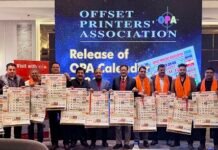Ricoh has highlighted its ValveJet printheads at the Fespa show in Amsterdam, with the announcement that these are now being offered to OEM customers for a variety of industrial applications.
Graham Kennedy, Ricoh Europe’s director of industrial print solutions, explains the advantage of using ValveJet over piezo heads, “It’s about larger drops for fast area coverage. You have larger throw distances where you are not limited to having to decorate on a flat surface. And then high viscosity ink so you could move to automotive painting where the inks are more than 100 cp.”
The principles behind the Valvejet approach are fairly simple. There is a hole at one end of the fluid chamber, which is closed by a valve and Ricoh is using a piezo actuator to open and close this valve. The fluid is supplied from a pressurized tank so that when the nozzle is opened, the air pressure is enough to force the dropout. It’s not suitable for highly detailed work – typically having around 70 – 140 dpi, though Ricoh says this could be improved on.
Yoshihiro Moriya, head of inkjet engineering at Ricoh UK’s Inkjet Technical Centre, explains that by controlling the length of time the nozzle is opened, it’s possible to determine the size of the drop. It’s also possible to multi-pulse the drops, for example, firing three small drops that could combine in flight to create a larger drop before reaching the substrate.
The ValveJet heads are available as either single nozzle NT units or as the Gelart printhead, which has eight nozzles combined. The advantage of the single nozzle units is that integrators are free to decide how many channels they need and how they want them arranged. They can then be configured on a block – effectively a printhead – with the electronics, as can be seen in the picture, where the black module in the center of the image is the printhead unit with the silver NT nozzles. Jason Remnant, strategic business development for Ricoh Europe, points out, “It’s easier for OEMs to integrate it as a printhead. A customer can create their own block and add their own value or they can buy a pre-made head with eight channels.”
To illustrate this, Ricoh has shown off a tire-printing application, which combines six single nozzle units together, one each for jetting CMYK, plus white and a primer. Kennedy explains: “We put the primer down first and then heat up the tire to about 120°C and this excites the surface and the ink is cured directly on the surface as the tire cools.”
Kennedy says that there is a lot of interest in this solution for sports such as Formula 1 as well as touring car racing, where the vehicles are wrapped with advertising and branding so the tires are an extension of this. The same can also be used for customizing vehicles for private use. Kennedy points out that tire printing offers another way of adding value and differentiation. The inks are water-based but can last for up to a year, which is likely to be the lifespan of the tires themselves.
I wrote about Ricoh’s ValveJet heads when they were first introduced two years ago. Since then Ricoh has been developing print systems with these heads for the last two years and has a number of solutions. This includes one for printing directly to gas cylinders, another for the sides of trucks as well as for shutters for retail units. Ricoh is open to working with OEMs for variations on these devices but is also hoping to talk to integrators that want to use the ValveJet approach to create their own solutions.
Kennedy says, “This is the first time we have shown this for OEMs, just to gauge where the interest lies. We will develop the story ready for Drupa and will have more of an opportunity to engage with a wider range of OEMs at a much bigger event.”

















